Choy Lee Fut 蔡李佛 - Pun Kiu 蟠橋 and Sau Ceoi 捎搥 by Elder Du Hon Cheung and Master Chu Siu Kee
Pun Kiu 蟠橋
In literal terms, it is difficult to provide a definitive explanation. However, from the meaning of the character “蟠” (pun), there are expressions like “old tree with coiled roots” and “coiled dragon raising its head.” The “蟠” in the former has the meaning of coiling, meaning tightly coiled without loosening, freely winding around. The “蟠” in “蟠龍” (coiled dragon) has the meaning of circling. A coiled dragon is a very long dragon curled into a dragon circle like a round cake. Within the coiled dragon’s domain, no animal can approach. However, despite this, the coiled dragon remains very agile and can move freely left and right. Moreover, in its rotating and coiling movements, it possesses infinite power and incredible speed. The Pun Kiu 蟠橋 hand technique in Choy Lee Fut 蔡李佛 adopts this form of movement and meaning. The “橋” (kiu) in Pun Kiu 蟠橋 refers to the hand bridge. The complete meaning of Pun Kiu 蟠橋 is that the hand bridge rotates like a coiled dragon to unleash its power. In actual combat, it is used to control the opponent’s bridge hands, using clever force to move the enemy’s body, causing them to lose their balance.
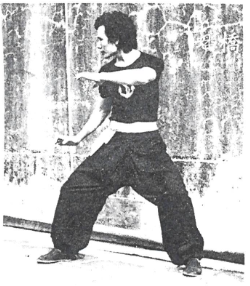
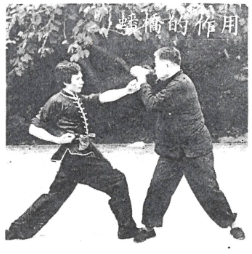
The Function of Pun Kiu 蟠橋
At the same time, in the process of Pun Kiu 蟠橋, if one can truly understand the function of Pun Kiu 蟠橋 deeply, it is fundamentally an extraordinary and unique lethal technique. Apart from the aforementioned ability to move the enemy’s body, it can also be used in actual combat to whip the center of gravity of Pun Kiu 蟠橋 toward the enemy’s vulnerable areas like the elbow, neck, etc., like a soft vine, causing injury. This is Pun Kiu 蟠橋’s independent attacking technique. And in another special circumstance? If the opponent is a person with very strong power, and the Pun Kiu 蟠橋 user has weaker power, under normal circumstances, it would be very difficult to achieve coiling away the enemy’s bridge hands and directly injuring the enemy. In this situation, one should use body positioning, meaning that under accurate prediction, use the Pun Kiu 蟠橋 hand to make frontal contact with the enemy’s bridge hands, while I use the walking horse and side-body method combined with other hand techniques to attack the enemy. The purpose is to use the Pun Kiu 蟠橋 hand to control the enemy’s direction and hope to disturb the enemy’s stability under reasonable circumstances. Of course, the Pun Kiu 蟠橋 hand is not limited to the above uses; this depends on the environment one is in.
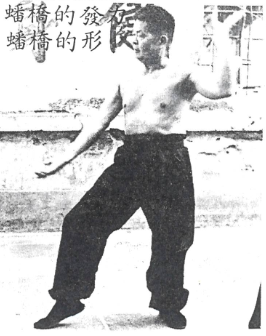
The Form of Pun Kiu 蟠橋
Simply put, there are single Pun Kiu 蟠橋 and double Pun Kiu 蟠橋. In usage, there are also side-body Pun Kiu 蟠橋, front-body Pun Kiu 蟠橋, and hanging horse Pun Kiu 蟠橋, etc. In terms of environment, there are advancing horse Pun Kiu 蟠橋, retreating horse 上 ⾺ Pun Kiu 蟠橋, and swallowing horse 落馬 Pun Kiu 蟠橋. However, in the actual application, there are no fixed limitations. Moreover, under suitable circumstances, advancing and retreating, rising and falling are often mixed together to attack and defend around the opponent from different angles. Because of this, it is very difficult to determine the exact form of Pun Kiu 蟠橋. In general, the form of Pun Kiu 蟠橋 is the bridge hands making circular rotations around one’s own body. However, in the continuous rotation process, there must be appropriate range and force.

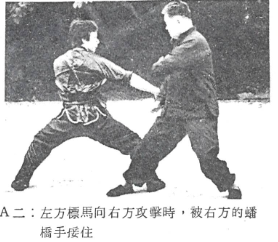
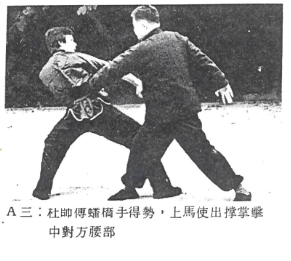
The Power Generation of Pun Kiu 蟠橋
Because Pun Kiu 蟠橋 has no fixed position, its force is very difficult to determine how to generate. However, for a more experienced practitioner, they must clearly control the force’s focal point with heart method. This is heart force. However, from experience, the entire process of Pun Kiu 蟠橋, its force uses a movement of one loose, one tight, one release, one pull. In this complex process, the practitioner must have great stability. Otherwise, the force generated by the Pun Kiu 蟠橋 hand might cause one’s own body to be moved due to lack of control. Because the force exerted when using Pun Kiu 蟠橋 is completely natural, with no accurate estimation. It can be said that the power generation of Pun Kiu 蟠橋 is natural force.
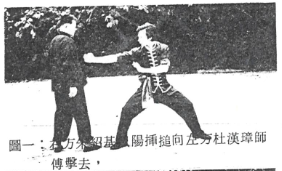
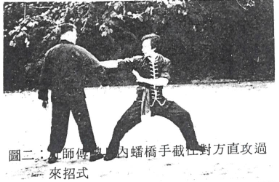
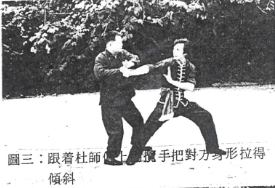
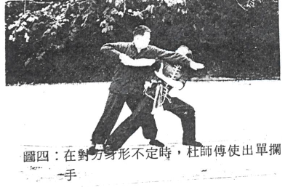
Sau Ceoi 捎搥
The Meaning of Sau Ceoi 捎搥
In Choy Lee Fut 蔡李佛 techniques, Sau Ceoi 捎搥 belongs to the hand technique with the largest attack area and heaviest force. In practical terms, Sau Ceoi 捎搥 has a larger circle, so when throwing the punch, there might be gaps, and if the opponent forces steps and captures the horse, it becomes difficult to retract the hand. Therefore, in actual combat, Sau Ceoi 捎搥 is often preceded by Pun Kiu 蟠橋 or other hand techniques to control the opponent’s attack range, then Sau Ceoi 捎搥 is executed from above downward toward the enemy’s temple or various parts of the face. It is believed that if Sau Ceoi 捎搥 unleashes its power, the opponent will surely be injured. Sau Ceoi 捎搥 was originally called “掃搥” (sou ceoi), but because Choy Lee Fut 蔡李佛 originated from Yim Sai Keng Mui, the local dialect and correct pronunciation of characters often differ, reading “掃” (sou) as “捎” (siu), so gradually the name Sau Ceoi 捎搥 surpassed Sou Ceoi 掃搥. The original meaning of Sou Ceoi 掃搥 was “sweeping thousands of armies.” In boxing methods, “掃” means sweeping the fist across. In many styles, there are also techniques similar to Sau Ceoi 捎搥. In practice, the execution of Sau Ceoi 捎搥 is very natural. Even someone who has never learned boxing knows how to use it, but whether the angle and power generation are correct requires much study.
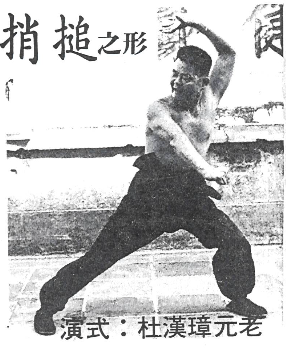
The Form of Sau Ceoi 捎搥
Sau Ceoi 捎搥 has no definite form. Because this method belongs to a broader range of attacking hand techniques, regardless of how large the circle of Sau Ceoi 捎搥 is, the fist moves from above horizontally downward. In actual combat, the execution of Sau Ceoi 捎搥 is often combined with advancing horse, retreating horse, and body rotation methods. As for the form of Sau Ceoi 捎搥 itself, in explanation, the tightly clenched fist is like a hard bronze bell, the arm is like a soft silk ribbon, and the body is the dynamic axis. The axis drives the silk ribbon to make the bronze bell rotate. When reaching a certain range, the bronze bell’s momentum has separated from the silk ribbon’s driving force and only relies on the silk ribbon for an accurate angle, forming a fan shape from above downward within a certain range. In Choy Lee Fut 蔡李佛 boxing techniques, Sau Ceoi 捎搥 has large circle (external gate hands) and small circle (internal gate hands) distinctions. Large circle Sau Ceoi 捎搥 moves the hand over the head and down, while small circle Sau Ceoi 捎搥 only does bridge cutting, elbow sinking, and half-circle movement from above downward. However, its form is always fan-shaped, just differentiated by large and small.
The Function of Sau Ceoi 捎搥
Because the form of Sau Ceoi 捎搥 is like a bronze bell, the arm like a silk ribbon, and the body is the dynamic axis, the bronze bell is attached to one end of the silk ribbon. As long as the silk ribbon is pushed by dynamic force to lead the bronze bell from one side to rotate to the other end, the bronze bell becomes a kind of flying momentum. In this situation, the silk ribbon’s function is no longer driving but becomes a kind of limitation. In other words, the length of the silk ribbon limits the bronze bell’s distance. Because the silk ribbon’s nature is soft, no matter how fast the bronze bell rotates, the silk ribbon absolutely does not affect its speed. In actual combat, if an obstacle contacts the bronze bell, it will be struck by the bronze bell’s high-speed rotating force. In another situation, if the silk ribbon encounters an obstacle, the bronze bell will rapidly strike the object behind the obstacle. This means that in actual combat, if I execute Sau Ceoi 捎搥 and the opponent uses bridge hands to block my bridge hands, attempting to stop my Sau Ceoi 捎搥, in this situation, only the bridge hands are blocked by the opponent, while Sau Ceoi 捎搥 still strikes downward. Behind the opponent’s bridge hands is the head area. Because when executing Sau Ceoi 捎搥, the bridge hands are kept as soft as possible, so when the bridge hands encounter obstacles, only the bridge hands stop advancing, while Sau Ceoi 捎搥 is completely unaffected. This is because the connection between Sau Ceoi 捎搥 and the bridge hands is like the connection between the bronze bell and silk ribbon, with no difference. Therefore, in actual combat, if Sau Ceoi 捎搥 is used for attack, dodging is believed to be the only method.
The Force of Sau Ceoi 捎搥
Because Sau Ceoi 捎搥 has large circle and small circle distinctions, there must be differences in its power generation. For large circle Sau Ceoi 捎搥, because its movement is from above, sweeping down from above, in its fixed fan-shaped space, there is a quite long distance. Therefore, large circle Sau Ceoi 捎搥 has the opportunity to generate force in space to strike the enemy fiercely. This force is not far from chopping force. Although small circle power generation is different from large circle, although both are Sau Ceoi 捎搥, both also attack in fan shape from above downward, but for small circle Sau Ceoi 捎搥, because it is often executed after Gwaa Ceoi 掛搥 or Hui Ceoi 揮搥, when encountering enemy obstruction, it then turns to Sau Ceoi 捎搥. Therefore, small circle Sau Ceoi 捎搥 at most sinks the bridge, moves the hand over the enemy’s bridge hands, then sweeps from above horizontally downward. In this short distance, it is difficult to borrow space to generate chopping force. Therefore, in this short distance, whether bridge hands or fist are like a vine springing over, but the force loses direction. Here, Sau Ceoi 捎搥 can only borrow waist and horse force, channeled through the hand bridge to penetrate the fist, making Sau Ceoi 捎搥 powerful. This force, because it belongs to short-distance power generation, only high-speed explosive force can achieve lethal short-distance power generation. This is not just bridge hand force; it can be said to be whole-body force generated at one point. This high-speed explosive force belongs to soft force, also called internal force.
The Method of Sau Ceoi 捎搥
One: Left side Chu Siu Kee takes stance to attack right side Master Du Hon Cheung
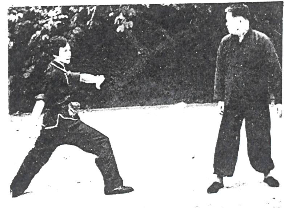
Two: When the Coeng Ngaan Ceoi 搶眼搥 is thrown, Master Du Hon Cheung uses Cyun Kiu Sau 穿橋手 to catch it
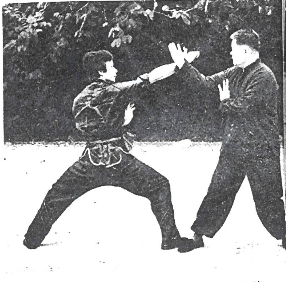
Three: Left side loses position, then changes technique to throw left punch attack, but is caught by right side’s Pun Kiu Sau 蟠橋手
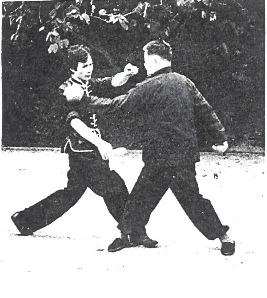
Four: Master Du’s Pun Kiu 蟠橋 changes to Laam Sau 攬手 to pull the opponent off balance, executing Ceoi 搥 toward the opponent’s head

Practical Application of Sau Ceoi 捎搥
One: Right side Chu Siu Kee Biu Ma 標馬 attacks left side Master Du Hon Cheung

Two: In this situation, Master Du advances horse Cyun Lou 穿撈 to intercept the incoming force
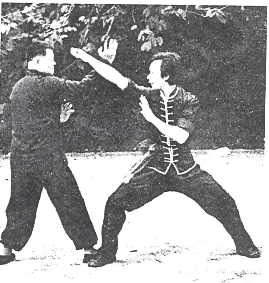
Three: When the opponent changes technique to throw left punch, Master Du’s Pun Kiu 蟠橋 follows the momentum to catch it
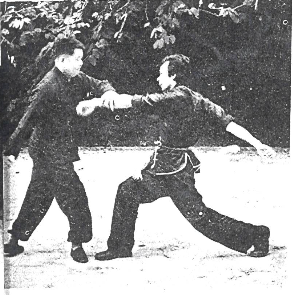
Four: After the left Pun Kiu Sau 蟠橋 hand gains advantage, Master Du executes low Sau Ceoi 捎搥 to counterattack
